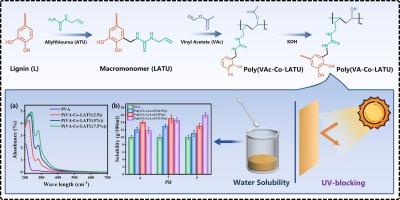具有更强紫外线阻隔性能和水溶性的木质化 PVA 共聚物的合成与特性
IF 5.8
2区 化学
Q1 POLYMER SCIENCE
引用次数: 0
摘要
人们对环境问题的关注与日俱增,因此对可持续材料的追求也随之提高,其中尤以可生物降解聚合物为重点。聚乙烯醇(PVA)作为一种公认的可生物降解合成聚合物,面临着成本高、生物降解慢、抗紫外线能力有限等挑战。本研究探讨了木质素这种丰富且环保的生物聚合物,并将其作为一种具有成本效益的添加剂,通过共聚技术提高 PVA 的性能。利用曼尼希反应将木质素与烯丙基硫脲有效地烷基化,从而合成了木质素基大单体(LATU)。随后,LATU 大单体与醋酸乙烯共聚,在 70 °C 下反应 6 小时,生成聚(VAc-Co-LATU)共聚物。最后,共聚物用氢氧化钾水解(皂化),得到聚(VA-Co-LATU)共聚物。包括傅立叶变换红外光谱、XPS、XRD 和 1H NMR 在内的广泛研究有效地验证了共聚物的合成。单体转化率高达 89% 以上,充分证明了合成方法的有效性。LATU 的添加直接影响了共聚物的晶体结构。X 射线衍射图样显示结晶度降低,进而影响合成共聚物的其他性能。因此,与 PVA 相比,木质化共聚物聚(VA-co-LATU)的分子量(Mw)略有降低,紫外线阻隔效果有所提高,在水中的溶解度也更大。这项研究证明了使用木质素作为单体来制造新型生物基聚合物材料的可行性,这些材料具有某些应用所需的特性。本文章由计算机程序翻译,如有差异,请以英文原文为准。

Synthesis and characteristics properties of lignified PVA copolymer with enhanced UV-blocking performance and water solubility
The increasing environmental concerns have heightened the pursuit of sustainable materials, with a particular emphasis on biodegradable polymers. Polyvinyl alcohol (PVA), a recognized biodegradable synthetic polymer, faces challenges such as cost, slow biodegradation, and limited UV resistance. This study explores lignin, an abundant and eco-friendly biopolymer, as a cost-effective additive to enhance PVA properties via the copolymerization technique. The Mannich reaction was utilized to effectively alkylate lignin with allylthiourea, leading to the synthesis of a lignin-based macromonomer (LATU). Subsequently, the LATU macromonomer was copolymerized with vinyl acetate, producing Poly(VAc-Co-LATU) copolymer in a reaction conducted at 70 °C for 6 h. Finally, the copolymers were hydrolyzed (saponification) with potassium hydroxide to obtain Poly(VA-Co-LATU) copolymers. Extensive investigations, including FTIR, XPS, XRD, and 1H NMR, effectively validated the synthesis of the copolymers. The high monomer conversion rate above 89 % emphasizes the effectiveness of the synthesis method. The addition of LATU has a direct impact on the crystalline structure of the copolymer. X-ray diffraction patterns indicate a reduction in crystallinity, which in turn affects the other properties of the synthesized copolymers. Consequently, the lignified copolymer, Poly(VA-co-LATU), exhibited slight decrease in molecular weight (Mw), improved UV-blocking effectiveness, and greater solubility in water as comparison to PVA. This study demonstrates the feasibility of using lignin as a monomer to create novel bio-based polymeric materials that exhibit the necessary properties for certain applications.
求助全文
通过发布文献求助,成功后即可免费获取论文全文。
去求助
来源期刊

European Polymer Journal
化学-高分子科学
CiteScore
9.90
自引率
10.00%
发文量
691
审稿时长
23 days
期刊介绍:
European Polymer Journal is dedicated to publishing work on fundamental and applied polymer chemistry and macromolecular materials. The journal covers all aspects of polymer synthesis, including polymerization mechanisms and chemical functional transformations, with a focus on novel polymers and the relationships between molecular structure and polymer properties. In addition, we welcome submissions on bio-based or renewable polymers, stimuli-responsive systems and polymer bio-hybrids. European Polymer Journal also publishes research on the biomedical application of polymers, including drug delivery and regenerative medicine. The main scope is covered but not limited to the following core research areas:
Polymer synthesis and functionalization
• Novel synthetic routes for polymerization, functional modification, controlled/living polymerization and precision polymers.
Stimuli-responsive polymers
• Including shape memory and self-healing polymers.
Supramolecular polymers and self-assembly
• Molecular recognition and higher order polymer structures.
Renewable and sustainable polymers
• Bio-based, biodegradable and anti-microbial polymers and polymeric bio-nanocomposites.
Polymers at interfaces and surfaces
• Chemistry and engineering of surfaces with biological relevance, including patterning, antifouling polymers and polymers for membrane applications.
Biomedical applications and nanomedicine
• Polymers for regenerative medicine, drug delivery molecular release and gene therapy
The scope of European Polymer Journal no longer includes Polymer Physics.
 求助内容:
求助内容: 应助结果提醒方式:
应助结果提醒方式:


